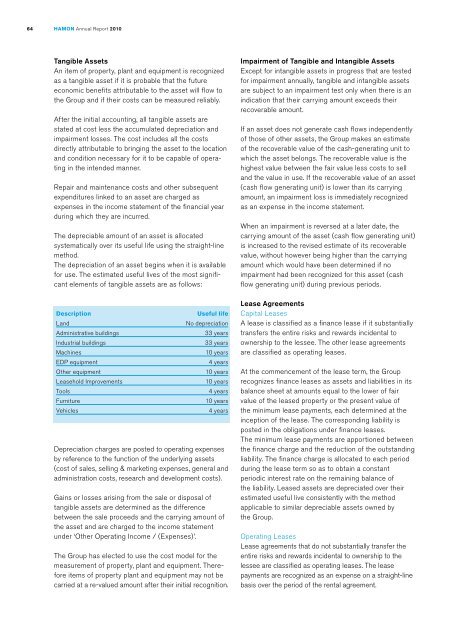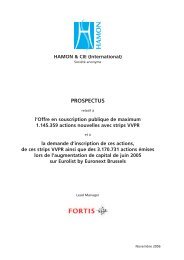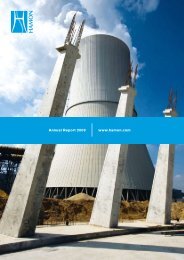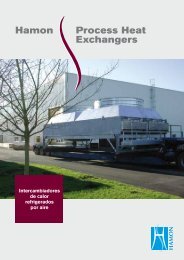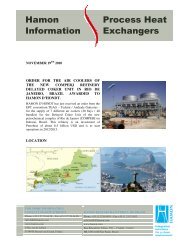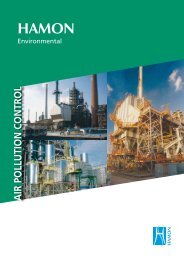Download PDF version English(2664KB) - Hamon
Download PDF version English(2664KB) - Hamon
Download PDF version English(2664KB) - Hamon
You also want an ePaper? Increase the reach of your titles
YUMPU automatically turns print PDFs into web optimized ePapers that Google loves.
64<br />
<strong>Hamon</strong> Annual Report 2010<br />
Tangible Assets<br />
An item of property, plant and equipment is recognized<br />
as a tangible asset if it is probable that the future<br />
economic benefits attributable to the asset will flow to<br />
the Group and if their costs can be measured reliably.<br />
After the initial accounting, all tangible assets are<br />
stated at cost less the accumulated depreciation and<br />
impairment losses. The cost includes all the costs<br />
directly attributable to bringing the asset to the location<br />
and condition necessary for it to be capable of operating<br />
in the intended manner.<br />
Repair and maintenance costs and other subsequent<br />
expenditures linked to an asset are charged as<br />
expenses in the income statement of the financial year<br />
during which they are incurred.<br />
The depreciable amount of an asset is allocated<br />
systematically over its useful life using the straight-line<br />
method.<br />
The depreciation of an asset begins when it is available<br />
for use. The estimated useful lives of the most significant<br />
elements of tangible assets are as follows:<br />
Description<br />
Land<br />
Administrative buildings<br />
Industrial buildings<br />
Machines<br />
EDP equipment<br />
Other equipment<br />
Leasehold Improvements<br />
Tools<br />
Furniture<br />
Vehicles<br />
Useful life<br />
No depreciation<br />
33 years<br />
33 years<br />
10 years<br />
4 years<br />
10 years<br />
10 years<br />
4 years<br />
10 years<br />
4 years<br />
Depreciation charges are posted to operating expenses<br />
by reference to the function of the underlying assets<br />
(cost of sales, selling & marketing expenses, general and<br />
administration costs, research and development costs).<br />
Gains or losses arising from the sale or disposal of<br />
tangible assets are determined as the difference<br />
between the sale proceeds and the carrying amount of<br />
the asset and are charged to the income statement<br />
under ‘Other Operating Income / (Expenses)’.<br />
The Group has elected to use the cost model for the<br />
measurement of property, plant and equipment. Therefore<br />
items of property plant and equipment may not be<br />
carried at a re-valued amount after their initial recognition.<br />
Impairment of Tangible and Intangible Assets<br />
Except for intangible assets in progress that are tested<br />
for impairment annually, tangible and intangible assets<br />
are subject to an impairment test only when there is an<br />
indication that their carrying amount exceeds their<br />
recoverable amount.<br />
If an asset does not generate cash flows independently<br />
of those of other assets, the Group makes an estimate<br />
of the recoverable value of the cash-generating unit to<br />
which the asset belongs. The recoverable value is the<br />
highest value between the fair value less costs to sell<br />
and the value in use. If the recoverable value of an asset<br />
(cash flow generating unit) is lower than its carrying<br />
amount, an impairment loss is immediately recognized<br />
as an expense in the income statement.<br />
When an impairment is reversed at a later date, the<br />
carrying amount of the asset (cash flow generating unit)<br />
is increased to the revised estimate of its recoverable<br />
value, without however being higher than the carrying<br />
amount which would have been determined if no<br />
impairment had been recognized for this asset (cash<br />
flow generating unit) during previous periods.<br />
Lease Agreements<br />
Capital Leases<br />
A lease is classified as a finance lease if it substantially<br />
transfers the entire risks and rewards incidental to<br />
ownership to the lessee. The other lease agreements<br />
are classified as operating leases.<br />
At the commencement of the lease term, the Group<br />
recognizes finance leases as assets and liabilities in its<br />
balance sheet at amounts equal to the lower of fair<br />
value of the leased property or the present value of<br />
the minimum lease payments, each determined at the<br />
inception of the lease. The corresponding liability is<br />
posted in the obligations under finance leases.<br />
The minimum lease payments are apportioned between<br />
the finance charge and the reduction of the outstanding<br />
liability. The finance charge is allocated to each period<br />
during the lease term so as to obtain a constant<br />
periodic interest rate on the remaining balance of<br />
the liability. Leased assets are depreciated over their<br />
estimated useful live consistently with the method<br />
applicable to similar depreciable assets owned by<br />
the Group.<br />
Operating Leases<br />
Lease agreements that do not substantially transfer the<br />
entire risks and rewards incidental to ownership to the<br />
lessee are classified as operating leases. The lease<br />
payments are recognized as an expense on a straight-line<br />
basis over the period of the rental agreement.


